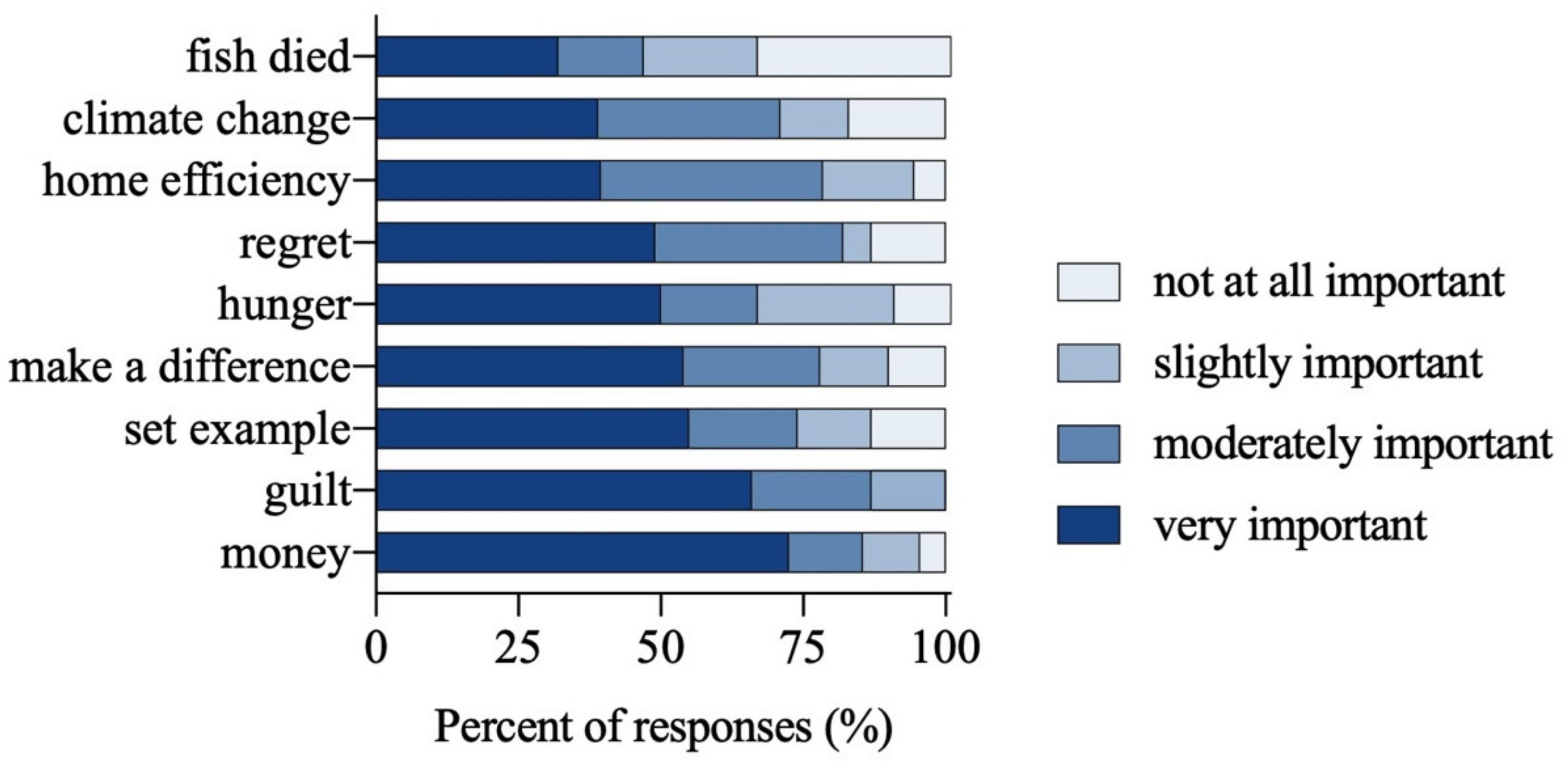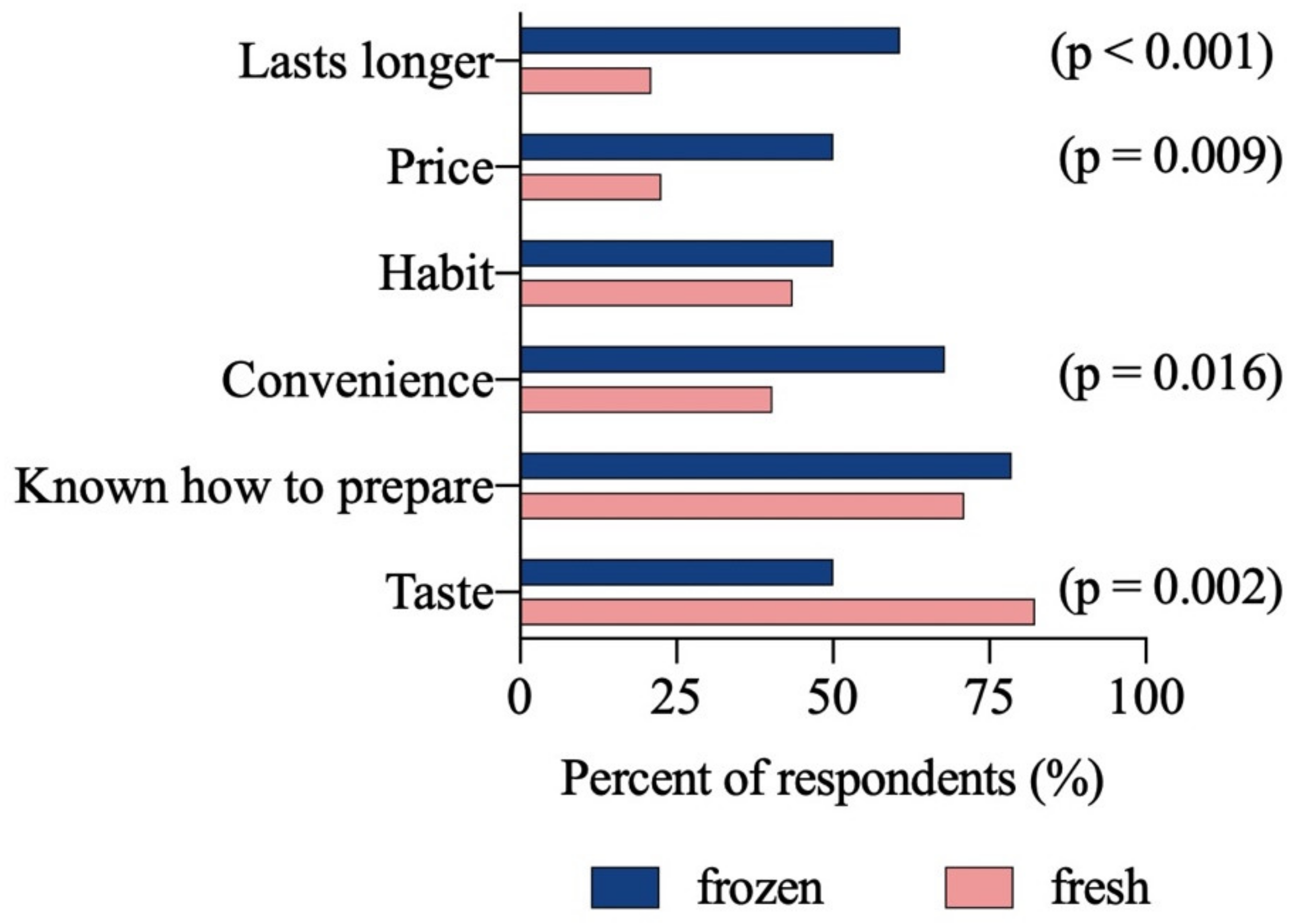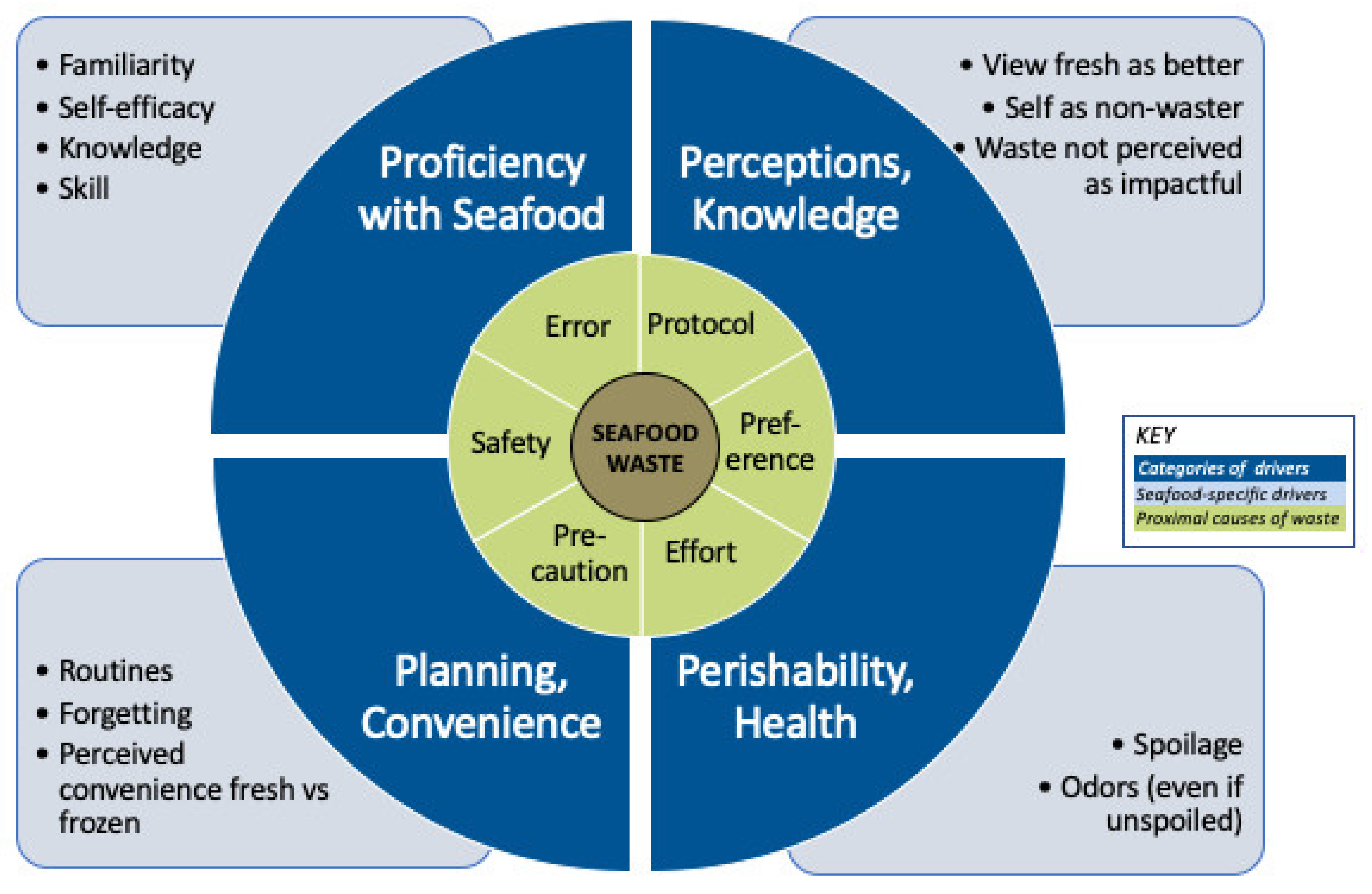Consumer Seafood Waste and the Potential of a ‘Direct-from-Frozen’ Approach to Prevention
Abstract
:1. Introduction
2. Materials and Methods
2.1. Food Retail Interviews
2.2. Consumer Seafood Waste Diaries and Surveys
2.3. Consumer Focus Groups
2.4. Concept Model
3. Results
3.1. Sample
3.2. Seafood Waste Quantification
3.2.1. Retail Seafood Managers
3.2.2. Consumers
3.3. Attitudes Regarding Frozen Seafood
3.3.1. Retail Seafood Managers
3.3.2. Consumers
3.4. Views on Cooking ‘Direct-from-Frozen’
3.4.1. Retail Seafood Managers
3.4.2. Consumers
4. Discussion
4.1. Concept Model
4.2. Direct-from-Frozen Intervention
4.3. Seafood Waste Estimates
4.4. Strengths and Limitations
5. Conclusions
Supplementary Materials
Author Contributions
Funding
Informed Consent Statement
Data Availability Statement
Acknowledgments
Conflicts of Interest
References
- US EPA United States. 2030. Food Loss and Waste Reduction Goal. Available online: https://www.epa.gov/sustainable-management-food/united-states-2030-food-loss-and-waste-reduction-goal (accessed on 2 August 2021).
- 12.3.1 Global Food Losses. Sustainable Development Goals. Food and Agriculture Organization of the United Nations. Available online: http://www.fao.org/sustainable-development-goals/indicators/1231/en/ (accessed on 2 August 2021).
- Love, D.C.; Fry, J.P.; Milli, M.C.; Neff, R.A. Wasted Seafood in the United States: Quantifying Loss from Production to Consumption and Moving toward Solutions. Glob. Environ. Chang. 2015, 35, 116–124. [Google Scholar] [CrossRef] [Green Version]
- FAO. The State of World Fisheries and Aquaculture 2020: Sustainability in Action; The State of World Fisheries and Aquaculture (SOFIA); FAO: Rome, Italy, 2020; ISBN 978-92-5-132692-3. [Google Scholar]
- Love, D.C.; Asche, F.; Conrad, Z.; Young, R.; Harding, J.; Nussbaumer, E.M.; Thorne-Lyman, A.L.; Neff, R. Food Sources and Expenditures for Seafood in the United States. Nutrients 2020, 12, 1810. [Google Scholar] [CrossRef]
- Buzby, J.C.; Bentley, J.T.; Padera, B.; Campuzano, J.; Ammon, C. Updated Supermarket Shrink Estimates for Fresh Foods and Their Implications for ERS Loss-Adjusted Food Availability Data; Jean, C., Buzby, J.T., Bentley, B.P., Campuzano, J., Ammon, C., Eds.; Economic Research Service: Washington, DC, USA, 2016. [Google Scholar]
- O’Donnell, T.; Katz, S.H.; Romey, A.; Fulton, B.; Croskey, L.; Pearson, P.; Deutsch, J. Retail Seafood Waste Prevention: Reducing Retail and Consumer Fresh-Fish Waste by Cooking Directly from Frozen. Food Nutr. Sci. 2021, 12, 290–307. [Google Scholar] [CrossRef]
- Hoover, D.; Moreno, L. Estimating Quantities and Types of Food Waste at the City Level; Natural Resources Defense Council: Rome, Italy, 2017. [Google Scholar]
- Kim, B.F.; Santo, R.E.; Scatterday, A.P.; Fry, J.P.; Synk, C.M.; Cebron, S.R.; Mekonnen, M.M.; Hoekstra, A.Y.; de Pee, S.; Bloem, M.W.; et al. Country-Specific Dietary Shifts to Mitigate Climate and Water Crises. Glob. Environ. Chang. 2020, 62, 101926. [Google Scholar] [CrossRef]
- Troell, M.; Jonell, M.; Crona, B. Scoping Report: The Role of Seafood in Sustainable and Healthy Diets; The EAT-Lancet Commission/Stockholm Resilience Center: Stockholm, Sweden, 2019. [Google Scholar]
- Conrad, Z. Daily Cost of Consumer Food Wasted, Inedible, and Consumed in the United States, 2001–2016. Nutr. J. 2020, 19, 35. [Google Scholar] [CrossRef] [PubMed]
- Clark, M.A.; Springmann, M.; Hill, J.; Tilman, D. Multiple Health and Environmental Impacts of Foods. Proc. Natl. Acad. Sci. USA 2019, 116, 23357–23362. [Google Scholar] [CrossRef] [PubMed] [Green Version]
- Poore, J.; Nemecek, T. Reducing Food’s Environmental Impacts through Producers and Consumers. Science 2018, 360, 987–992. [Google Scholar] [CrossRef] [PubMed] [Green Version]
- Commission for Environmental Cooperation. Characterization and Management of Food Loss and Waste in North America; North American Initiatives on Food and Organic Waste: Montreal, Canada, 2017. [Google Scholar]
- Carlucci, D.; Nocella, G.; De Devitiis, B.; Viscecchia, R.; Bimbo, F.; Nardone, G. Consumer Purchasing Behaviour towards Fish and Seafood Products. Patterns and Insights from a Sample of International Studies. Appetite 2015, 84, 212–227. [Google Scholar] [CrossRef] [PubMed]
- Christenson, J.K.; O’Kane, G.M.; Farmery, A.K.; McManus, A. The Barriers and Drivers of Seafood Consumption in Australia: A Narrative Literature Review. Int. J. Consum. Stud. 2017, 41, 299–311. [Google Scholar] [CrossRef] [Green Version]
- Stein, R.; Markenson, S. The Power of Seafood 2019; Food Marketing Institute Report; FMI: Arlington, VA, USA, 2019. [Google Scholar]
- Lamy, J.; Szejda, K. Literature Review: Consumer Preferences for Seafood and Applications to Plant-Based and Cultivated Seafood; Research Report; Good Food Institute: Washington, DC, USA, 2020. [Google Scholar]
- Carstairs, S.A.; Marais, D.; Craig, L.C.A.; Kiezebrink, K. How Important Are the Influencing Factors to the Decision on Whether to Provide Seafood in Infant and Young Child Feeding? Appetite 2017, 117, 224–233. [Google Scholar] [CrossRef] [Green Version]
- Govzman, S.; Looby, S.; Wang, X.; Butler, F.; Gibney, E.R.; Timon, C.M. A Systematic Review of the Determinants of Seafood Consumption. Br. J. Nutr. 2021, 126, 66–80. [Google Scholar] [CrossRef]
- Birch, D.; Lawley, M. The Role of Habit, Childhood Consumption, Familiarity, and Attitudes Across Seafood Consumption Segments in Australia. J. Food Prod. Mark. 2014, 20, 98–113. [Google Scholar] [CrossRef]
- Birch, D.; Memery, J. Exploring the Influence of Family on Adolescents’ Seafood Consumption Choices. Int. J. Consum. Stud. 2020, 44, 499–510. [Google Scholar] [CrossRef]
- Deutsch, J.; Zeitz, A.; Croskey, L.; Fulton, B.; Trout, R.; Pearson, P. Eliminating Waste from the Seafood Supply Chain: The Benefits and Challenges of “Frozen”. Available online: https://drexel.edu/~/media/Files/cnhp/Faculty%20Pub%20PDF/WWF%20%20DREXEL%20Seafood%20White%20Paper%20v5.ashx?la=en (accessed on 18 September 2021).
- Committee on a Systems Approach to Reducing Consumer Food Waste; Board on Environmental Change and Society; Food and Nutrition Board; Division of Behavioral and Social Sciences and Education; Health and Medicine Division; National Academies of Sciences, Engineering, and Medicine. A National Strategy to Reduce Food Waste at the Consumer Level; Schneeman, B.O., Oria, M., Eds.; National Academies Press: Washington, DC, USA, 2020; p. 25876. ISBN 978-0-309-68073-8. [Google Scholar]
- Van Geffen, L.E.J.; van Herpen, E.; van Trijp, J.C.M. Causes & Determinants of Consumers Food Waste, REFRESH; Wageningen University: Wageningen, The Netherlands, 2016. [Google Scholar]
- Neff, R.A.; Spiker, M.L.; Truant, P.L. Wasted Food: U.S. Consumers’ Reported Awareness, Attitudes, and Behaviors. PLoS ONE 2015, 10, e0127881. [Google Scholar] [CrossRef] [Green Version]
- Tracy, S.J. Qualitative Research Methods: Collecting Evidence, Crafting Analysis, Communicating Impact; John Wiley & Sons, Incorporated: Chicester, UK, 2013; ISBN 978-1-118-37858-8. [Google Scholar]
- Aschemann-Witzel, J.; De Hooge, I.; Amani, P.; Bech-Larsen, T.; Oostindjer, M. Consumer-Related Food Waste: Causes and Potential for Action. Sustainability 2015, 7, 6457–6477. [Google Scholar] [CrossRef] [Green Version]
- Freidberg, S. Fresh: A Perishable History; Harvard University Press: Boston, MA, USA, 2010. [Google Scholar]
- ReFED. ReFED Date Labeling Standardization Tool; ReFED: New York, NY, USA, 2017; Available online: https://refed.org/downloads/ReFED-Standardization-Package.pdf (accessed on 18 September 2021).
- Block, L.G.; Keller, P.A.; Vallen, B.; Williamson, S.; Birau, M.M.; Grinstein, A.; Haws, K.L.; LaBarge, M.C.; Lamberton, C.; Moore, E.S.; et al. The Squander Sequence: Understanding Food Waste at Each Stage of the Consumer Decision-Making Process. J. Public Policy Mark. 2016, 35, 292–304. [Google Scholar] [CrossRef]
- ASMI Cook It Frozen. Available online: https://www.wildalaskaseafood.com/slideshow/cook-it-frozen/ (accessed on 18 September 2021).
- Muth, M.K. Consumer-Level Food Loss Estimates and Their Use in the ERS Loss-Adjusted Food Availability Data; DIANE Publishing: Darby, PA, USA, 2011; ISBN 1-4379-4430-2. [Google Scholar]



| Store Type | Geography, Store Outlets | SKUs a | Shrink Rates | |||
|---|---|---|---|---|---|---|
| N | Fresh | Frozen | Fresh | Frozen | ||
| supermarket | national, chain | 130 | 42% | 58% | 25 items or USD 300/wk | negligible |
| supermarket | regional, chain | 100 | 10% | 90% | 5% | n/a |
| grocery store | local, chain | 100 | 50% | 50% | 5% | “if something goes wrong like somebody leaves a frozen fish in the bread section or a freezer breaks down.” |
| specialty supermarket | national, chain | 70 | 35% | 65% | 7% | 0% |
| supermarket | regional, chain | 50 | 40% | 60% | 3% | “not as often as fresh; only loss is from freezer burn” |
| grocery store | single store | 50 | 50% | 50% | unknown | unknown |
| supermarket | regional, chain | 25 | 60% | 40% | “I usually don’t have too much because I order little amounts” | “I really can’t tell” |
| budget supermarket | regional, chain | 20 | 50% | 50% | a few items a week | “next to none” |
| Seafood Product Form | Purchased at Retail (n = 209) | Prepared at Home b (n = 195) | Discarded (n = 59) |
|---|---|---|---|
| Fresh | 36% | 36% | 36% |
| Frozen | 23% | 31% | 24% |
| Shelf-stable | 20% | 21% | 12% |
| Prepared/cooked | 12% | 6% | 24% |
| Other | 8% | 6% | 5% |
| Total | 100% | 100% | 100% |
| Total (g/d/hh) | 99.9 +/− 84.4 | 42.2 +/− 51.88 | 10.5 +/− 23.5 |
| Driver Category [24] | Reasons for Discards | How Discards Are Prevented |
|---|---|---|
| Proficiency | “Then sometimes I’m thinking the second day, ‘Should I put it in the freezer?’ and then it’s like, ‘Is it too late to freeze?‘ and then I’ve frozen some that I kept out and then I never used it… because every time I would take it out, I’d say, ‘I don’t think this is that good, ‘ and I end up throwing it away.” | |
| Planning | “But then in the summer … there’s so many other things we’re doing, we may defrost this fresh fish and we wind up having hotdogs on the grill … and pizza or whatever, two days has passed and then I start feeling bad.” | “I’m sorry but I came from a background where you don’t throw no food away, it’s hard to come by so I make sure to plan my meals so that I don’t have nothing to waste. Or before I throw it away I’ll put it in a container and give it to a homeless guy coming down the street.” |
| Price | “If I buy it fresh for what I paid for it, there is no way in the world it’s going in the trash. I bought a pint of crab cakes and I made four, a pound, and I ate all four of them because I refused to put them in the trash” | |
| Protocol | “But it’s the third day, it’s got to go.” | |
| Taste | “I don’t think it tastes good the next day after you cooked it, it just doesn’t have any—the refrigerator eats up sort of that flavor for me.” |
| Category | Reason for Choosing Fresh | Reason for Choosing Frozen |
|---|---|---|
| Perishability/Freshness | “Frozen, it could be in the freezer for months and months and months” | “At least if it’s frozen it’s got an expiration date on it, right. Whereas if it’s been sitting on ice it could very well be questionable as to how long it’s been sitting.” |
| Perceptions/Knowledge | “I just don’t like frozen because I think… it has too many preservatives, and it’s just processed, has too many chemicals in it.” | “Sometimes I feel like having fresh fish laying around in my refrigerator would open me up to more problems with food contamination.” |
| Planning/Convenience | “Frozen you have to give it time to thaw out and all that. So definitely, fresh is more convenient.” | “More for the convenience of having it in the freezer and the individually wrapped is good because … you can save the rest” |
| Price | “If I eat seafood…it’s like a luxury food. So therefore, I want the best.” | “Like, if it’s frozen but it‘s cheap, I’d probably buy it.” |
| Nutrition | “I know the fresh is healthier…. Because you don’t know how long that’s been sitting there in the freezer.” | “Over the years, I’ve tried to eat more fish, so it’s just easier and cheaper for me to have fish in the freezer at all times.” |
| Proficiency | “Seafood, I have to admit, I’m a little fussier about because I just think things can go wrong and I don’t feel that way about chicken or beef or whatever.” | |
| Taste | “Definitely fresh because frozen fish, I mean some can be okay but most of the time it loses that fish taste that you love.” |
| Negative | Positive | |
|---|---|---|
| Protocol/Novelty | “I tend to follow a lot of things that I saw my grandmother and my mother--… and I have never seen them take anything frozen and just cook it.” | “Well, I love watching cooking shows, so if I saw someone on a cooking show, like, go through these steps and I was convinced eough by watching them that it would work, I would try it.” |
| Protocol/Already do it | “9 times out of 10 when I’m cooking, it’s from a recipe, and the recipe either says to thaw it or do it fresh.“ | “I mean, it’s like defrosting in the microwave I mean everybody practically does that…so you just defrost it in the pan which isn’t as…hard as it seems; it’s not as crazy as it seems either.” |
| Anxiety/food safety | “I just would just be really concerned with fully cooking it through” | |
| Prevent waste: Perishability, Planning | “I do think if you bought frozen and then it thaws, I do feel like it would go bad faster than when you have fresh.” | “I would definitely throw away less… I wouldn’t have to make as much, because I know I could just take it out, heat it up and eat it.” |
| Negative | Positive | |
|---|---|---|
| Convenience | “Because there‘s too many steps and too many ingredients.” | “So, this right here, the time that it takes ––30 to 45 min from frozen which I have in the freezer––So this is amazing; this is helpful.” |
| Protocol/Novelty | “I wouldn’t care if it took five minutes; my food‘s got to be thawed out first.” | “I think that if the knowledge was out there, that it’s pretty much all frozen in the first place, I think more people would buy more frozen fish. I don’t think it would matter as much anymore. I’d be willing to try it all. I live a little bit on the edge and I love trying new things, so I’d be all for it.” |
| Taste | “I can just imagine the extra fishy, fishy taste from the stuff from it not being thawed out or rinsed off.” | “Because it looks very healthy and it’s everything on there that my son can eat.” |
Publisher’s Note: MDPI stays neutral with regard to jurisdictional claims in published maps and institutional affiliations. |
© 2021 by the authors. Licensee MDPI, Basel, Switzerland. This article is an open access article distributed under the terms and conditions of the Creative Commons Attribution (CC BY) license (https://creativecommons.org/licenses/by/4.0/).
Share and Cite
Neff, R.A.; Love, D.C.; Overbey, K.; Biehl, E.; Deutsch, J.; Gorski-Steiner, I.; Pearson, P.; Vigil, T.; Turvey, C.; Fry, J.P. Consumer Seafood Waste and the Potential of a ‘Direct-from-Frozen’ Approach to Prevention. Foods 2021, 10, 2524. https://doi.org/10.3390/foods10112524
Neff RA, Love DC, Overbey K, Biehl E, Deutsch J, Gorski-Steiner I, Pearson P, Vigil T, Turvey C, Fry JP. Consumer Seafood Waste and the Potential of a ‘Direct-from-Frozen’ Approach to Prevention. Foods. 2021; 10(11):2524. https://doi.org/10.3390/foods10112524
Chicago/Turabian StyleNeff, Roni A., David C. Love, Katie Overbey, Erin Biehl, Jonathan Deutsch, Irena Gorski-Steiner, Pete Pearson, Toriana Vigil, Catherine Turvey, and Jillian P. Fry. 2021. "Consumer Seafood Waste and the Potential of a ‘Direct-from-Frozen’ Approach to Prevention" Foods 10, no. 11: 2524. https://doi.org/10.3390/foods10112524
APA StyleNeff, R. A., Love, D. C., Overbey, K., Biehl, E., Deutsch, J., Gorski-Steiner, I., Pearson, P., Vigil, T., Turvey, C., & Fry, J. P. (2021). Consumer Seafood Waste and the Potential of a ‘Direct-from-Frozen’ Approach to Prevention. Foods, 10(11), 2524. https://doi.org/10.3390/foods10112524







